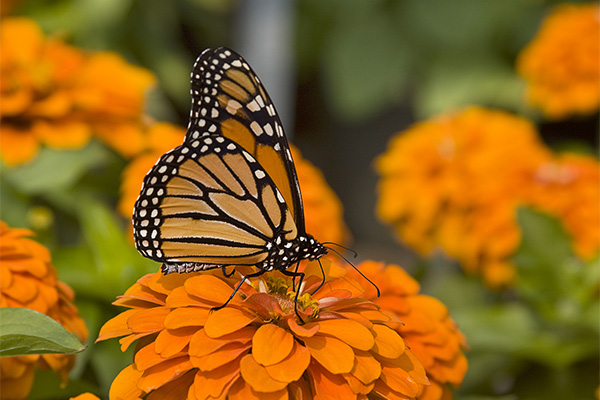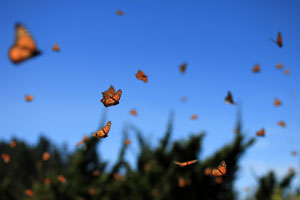Texas Tech To Play Major Role in Monarch Butterfly Restoration Research
By: Glenys Young
The collaborative project seeks to facilitate the species’ survival and reproduction.

Springtime in Texas used to come with millions of monarch butterflies migrating from their wintering grounds in Mexico to their summer home in the Midwest. It's a magnificent sight, but one that's been increasingly less visible each year.
"If people have noticed they don't see as many monarchs as they used to, there's something to it because their populations are diminishing very dramatically," said Ron Kendall, a professor of environmental toxicology in The Institute of Environmental and Human Health (TIEHH) at Texas Tech University. "It's estimated that more than 90 percent of the population has been lost over the last 20 years or so."
It's a problem Kendall hopes to reverse, thanks to a new collaboration with the University of Arkansas and the University of Minnesota funded by grants from chemical producer BASF. Texas Tech received $180,817 for its initial research efforts.
"Texas is critical to the monarch because of their migration patterns," Kendall said. "Various populations of these monarchs move through various parts of the United States, but the most important and major movement is from their wintering grounds in Mexico through Texas. If things aren't good in Texas as they're moving north for their spring reproduction, they're probably going to suffer the rest of the year."
One of the major factors in declining monarch populations is habitat loss. Some estimates show the butterflies have lost more than 165 million acres of their natural habitat – that's roughly the size of Texas.
"This research involves a better understanding of monarch needs, particularly the kinds of plants they need, both in their spring migration and fall migration, to facilitate their survival and reproduction," Kendall said. "It's a very interesting project, particularly for such an important, iconic species that's approaching a very serious population crisis."
The research, which is expected to last several years, has already begun.

"We're looking at a variety of plant issues as well as monarch utilization of those plants," Kendall said. "A plant particularly important to the monarch is milkweed; it's critical to their reproduction. A variety of flowering plants are also important. So we're looking at a variety of issues, with questions of habitat but also environmental contaminants and other risks to the species."
Through its research-based initiative Living Acres, BASF is focused on the monarch because of its effects on agriculture. As a pollinator of fruits, nuts and vegetables, monarchs play a vital role in the ecosystem and economy. Because of this, BASF hopes to encourage farmers to plant milkweed in non-cropland areas, such as ditches, roadsides, alleyways and border areas, to help increase monarch numbers. Milkweed is the only plant monarch butterfly larvae feed on, so it's a critical element in their life cycle.
"Restoring the monarch butterfly population will require collaboration from various entities and landowners," said Luke Bozeman, director of Research and Development Crop Protection for BASF. "Through these partnerships, BASF and university researchers will be able to share rich insights and determine the best approach for growing and restoring the monarch butterfly habitat."
The U.S. Fish & Wildlife Service is currently conducting an assessment to determine whether the monarch butterfly should be protected under the Endangered Species Act, but a ruling is still years away. A decision on the listing is expected in June 2019.
"This has taken on national importance because the monarch could possibly be listed as an endangered species," Kendall said. "If that ever did happen, it could have dramatic implications for agriculture. Right now we're collaborating with other teams in the United States to look at this from a regional and continental perspective."
Through the Wildlife Toxicology Laboratory at TIEHH, Kendall, his staff and students will be responsible for working on Texas Tech's role in the research: advancing scientific understanding of movement and population abundance of monarchs, particularly through the Rolling Plains ecoregion; and beginning to evaluate what kind of habitat improvements could occur that would help the species sustain itself.
The University of Arkansas will evaluate changes in monarch habitat, analyze current land availability, investigate the potential for habitat growth and develop a restoration and conservation plan for the monarchs' migratory flyway. The University of Minnesota will determine the feasibility of programs relying on farmer participation and identify the numbers and types of farmers likely to participate in milkweed establishment and maintenance.
Discoveries
-
Address
Texas Tech University, 2500 Broadway, Box 41075 Lubbock, TX 79409 -
Phone
806.742.3905 -
Email
vpr.communications@ttu.edu
